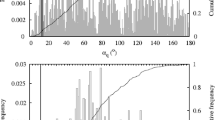Abstract
After decades of speculation1, the existence of binary asteroids has been observationally confirmed2,3, with examples in all minor planet populations4. However, no triple systems have hitherto been discovered. Here we report the unambiguous detection of a triple asteroidal system in the main belt, composed of a 280-km primary (87 Sylvia) and two small moonlets orbiting at 710 and 1,360 km. We estimate their orbital elements and use them to refine the shape of the primary body. Both orbits are equatorial, circular and prograde, suggesting a common origin. Using the orbital information to estimate its mass and density, 87 Sylvia appears to have a rubble-pile structure with a porosity of 25–60 per cent. The system was most probably formed through the disruptive collision of a parent asteroid, with the new primary resulting from accretion of fragments, while the moonlets are formed from the debris, as has been predicted previously5.



Similar content being viewed by others
References
Weidenschiling, S. J., Paolicchi, P. & Zappala, V. in Asteroids II (eds Binzel, R. P., Gehrels, T. & Matthews, M. S.) 643–658 (Univ. Arizona Press, Tucson, 1989)
Chapman, C. R. et al. Discovery and physical properties of Dactyl, a satellite of asteroid 243 Ida. Nature 374, 783–785 (1995)
Merline, W. J. L. et al. Discovery of a moon orbiting the asteroid 45 Eugenia. Nature 401, 565–568 (1999)
Merline, W. J. L., et al. in Asteroids III (eds Bottke, W. F., Cellino, A., Paolicchi, P. & Binzel, R. P.) 289–312 (Univ. Arizona Press, Tucson, 2002)
Michel, P., Benz, W., Tanga, P. & Richardson, D. C. Collision and gravitational reaccumulation: forming asteroid families and satellites. Science 294, 1696–1700 (2001)
Marchis, F. et al. A three-dimensional solution for the orbit of the asteroidal satellite of 22 Kalliope. Icarus 165, 112–120 (2003)
Marchis, F., Descamps, P., Berthier, J., Hestroffer, D. & de Pater, I. Fine analysis of 121 Hermione, 45 Eugenia, and 90 Antiope binary asteroid systems with AO observations. Bull. Am. Astron. Soc. Div. Planet. Sci. 36, 33.23 (2004)
Marchis, F. et al. Mass and density of asteroid 121 Hermione from an analysis of its companion orbit. Icarus (in the press)
Brown, M. E., Margot, J. L., de Pater, I. & Roe, H. S/2001(87)1. IAU Circ. No. 7588 (2001).
Storrs, A. et al. S/2001 (87) 1. IAU Circ. No. 7590 (2001).
Descamps, P. Orbit of a visual binary system. Bull. Am. Astron. Soc. Div. Dynam. Astron. 35, 04.01 (2005)
Margot, J. L. & Brown, M. E. Discovery and characterization of binary asteroids 22 Kalliope and 87 Sylvia. Bull. Am. Astron. Soc. Div. Planet. Sci. 33, 52.02 (2001)
Kaasalainen, M., Torppa, J. & Piironen, J. Models of twenty asteroids from photometric data. Icarus 159, 369–395 (2002)
Tedesco, E. F., Noah, P. V., Noah, M. & Price, S. D. The supplemental IRAS minor planet survey. Astron. J. 123, 1056–1085 (2002)
Bus, S. J. & Binzel, R. P. Phase II of the small main-belt asteroid spectroscopic survey. Icarus 158, 146–177 (2002)
Britt, D. T., Yeomans, D., Housen, K. & Consolmagno, G. in Asteroids III (eds Bottke, W. F., Cellino, A., Paolicchi, P. & Binzel, R. P.) 485–500 (Univ. Arizona Press, Tucson, 2002)
Clark, B. E. et al. Spectroscopy of X-type asteroids. Icarus 128, 3070–3081 (2004)
Durda, D. D. The formation of asteroidal satellites in catastrophic collisions. Icarus 120, 212–219 (1996)
Doressoundiram, A., Paolicchi, P., Verlicchi, A. & Cellino, A. The formation of binary asteroids as outcomes of catastrophic collisions. Planet. Space Sci. 45, 757–770 (1997)
Chauvineau, B., Farinella, P. & Mignard, F. Planar orbits about a triaxial body—Application to asteroidal satellites. Icarus 105, 370–384 (1993)
Scheeres, D. J. The effect of C22 on orbit energy and angular momentum. Celest. Mech. Dynam. Astron. 73, 339–348 (1999)
Petit, J.-M., Durda, D. D., Greenberg, R., Hurford, T. A. & Geissler, P. E. The long-term dynamics of Dactyl's orbit. Icarus 130, 177–197 (1997)
Acknowledgements
The observations reported here are based on data collected at the European Southern Observatory, Chile. This work was partially supported by the National Science Foundation Science and Technology Center for Adaptive Optics, managed by the University of California at Santa Cruz under a cooperative agreement, and by the Chretien International Research Grant of the American Astronomical Society.Author Contributions All authors contributed equally to this work.
Author information
Authors and Affiliations
Corresponding author
Ethics declarations
Competing interests
Reprints and permissions information is available at npg.nature.com/reprintsandpermissions. The authors declare no competing financial interests.
Supplementary information
Supplementary Table S1
This table contains the measurements performed on each observation for the analysis, such as the apparent shape of the primary (based on an ellipsoid fit in milli-arcsec), its orientation, the positions X and Y (in arcsec) of the moonlets and their sizes. (DOC 53 kb)
Rights and permissions
About this article
Cite this article
Marchis, F., Descamps, P., Hestroffer, D. et al. Discovery of the triple asteroidal system 87 Sylvia. Nature 436, 822–824 (2005). https://doi.org/10.1038/nature04018
Received:
Accepted:
Issue Date:
DOI: https://doi.org/10.1038/nature04018
- Springer Nature Limited
This article is cited by
-
PETREL19: a new numerical solution of planetary and lunar ephemeris
Celestial Mechanics and Dynamical Astronomy (2023)
-
Dynamical environment in the triple asteroid system 87 Sylvia
Astrophysics and Space Science (2019)
-
Relative Effect of Inclinations for Moonlets in the Triple Asteroidal Systems
Earth, Moon, and Planets (2017)
-
Dynamical configurations of celestial systems comprised of multiple irregular bodies
Astrophysics and Space Science (2016)
-
Topological classifications and bifurcations of periodic orbits in the potential field of highly irregular-shaped celestial bodies
Nonlinear Dynamics (2015)





